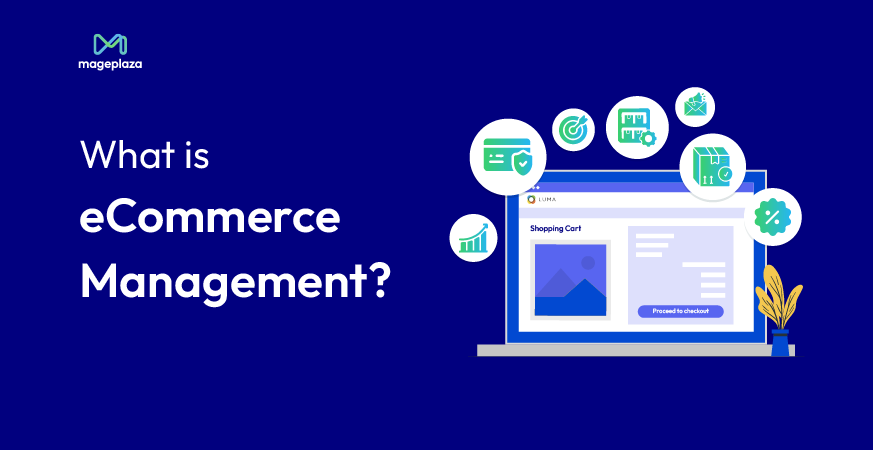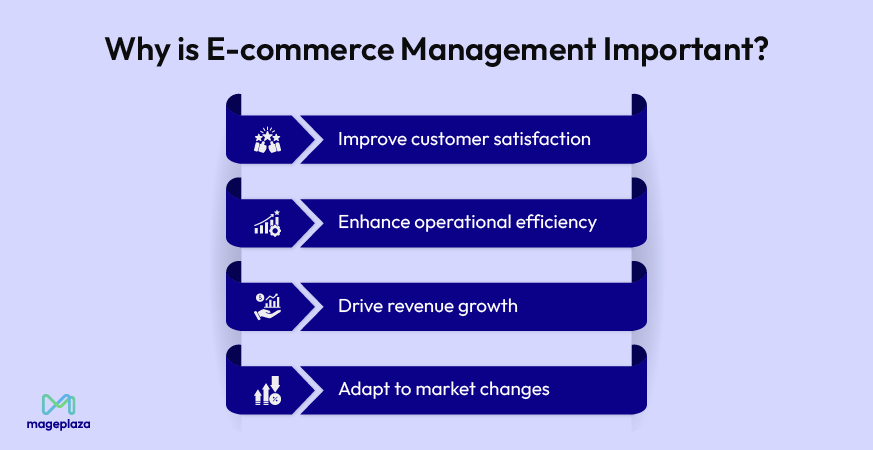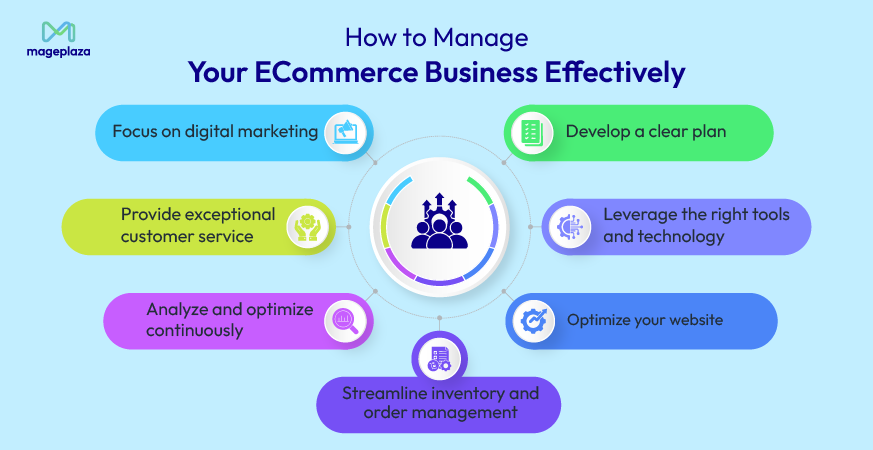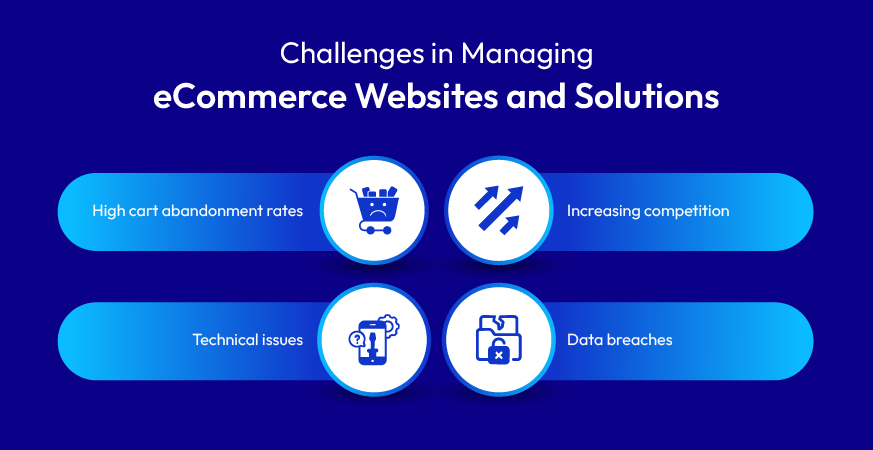The Ultimate Guide to Managing Your E-Commerce Website for Maximum Sales

Did you know that nearly 88% of online shoppers are less likely to return to a website after a poor experience? Or does slow-loading websites lead to an average loss of $2.6 billion in revenue annually?
Managing an e-commerce website isn’t just about having great products—it’s about creating a seamless shopping experience that keeps customers coming back. Effective e-commerce management optimizes every touchpoint, turning visitors into loyal customers. This guide will equip you with actionable insights to maximize your website’s performance, boost sales, and grow your online business effortlessly.
What is eCommerce Management?

E-commerce management involves overseeing and coordinating all aspects of an online business to ensure its efficient operation and success. This includes managing inventory to prevent stockouts or overstocking, maintaining optimal website performance to deliver a seamless shopping experience, processing payments securely, and enhancing user experience through intuitive design and navigation.
Additionally, eCommerce management encompasses implementing effective marketing strategies, such as SEO, email marketing, and targeted ads, to attract and retain customers. By adopting a holistic and proactive approach, eCommerce management ensures that every element of the online business works harmoniously, meeting customer expectations while driving sales and growth.
Key components of E-commerce management
Customer relationship management (CRM)
Building strong relationships with customers is essential for eCommerce success. Effective CRM leverages technology to analyze customer data, segment audiences, and deliver personalized experiences, such as tailored promotions and recommendations. This fosters loyalty, boosts repeat purchases, and strengthens brand trust.
Website performance and maintenance
A fast, intuitive, and mobile-responsive website is the cornerstone of any eCommerce business. Optimizing website performance enhances user experience, improves conversions, and boosts search engine rankings. Ensuring seamless navigation, fast load times, and a responsive design drives customer satisfaction and retention.
Inventory management
Efficient inventory management prevents stockouts or overstock issues, ensuring product availability and reducing operational costs. Accurate product listings with detailed descriptions and quality images help maintain customer trust and streamline purchasing decisions.
Marketing and promotions
Effective marketing strategies, such as SEO, social media campaigns, and email marketing, drive traffic and sales. Seasonal promotions, flash sales, and loyalty programs keep customers engaged and maintain a competitive edge in the market.
Order fulfillment and logistics
Streamlined order fulfillment is critical to customer satisfaction. Efficient processing, accurate packing, and reliable shipping ensure timely deliveries. Offering tracking details improves transparency and builds trust with customers.
Analytics and reporting
Data-driven insights empower businesses to optimize campaigns, improve performance, and identify trends. Tracking key metrics like conversion rates, average order value (AOV), and customer lifetime value (CLV) ensures informed decision-making.
Payment processing and security
Secure and flexible payment options, including credit cards and digital wallets, cater to diverse customer needs. Robust encryption and fraud prevention measures protect customer data and enhance trust in your eCommerce platform.
Why is E-commerce Management Important?

E-commerce management is a critical component for the success of any online business, as it directly impacts customer satisfaction, operational efficiency, revenue growth, and the ability to adapt to evolving market demands. Here’s why it matters:
1. Improve customer satisfaction
Effective eCommerce management ensures a seamless shopping experience by maintaining a fast, user-friendly website and offering reliable customer support. A smooth journey from product discovery to checkout builds trust and fosters loyalty, encouraging repeat purchases and positive word-of-mouth.
2. Enhance operational efficiency
Streamlined processes like inventory management, order fulfillment, and website maintenance reduce errors and save time. By optimizing operations, businesses can handle larger volumes of transactions while minimizing costs and resource waste, ensuring smooth day-to-day functioning.
3. Drive revenue growth
Well-managed eCommerce operations lead to better marketing strategies and superior customer experiences. From targeted advertising campaigns to personalized promotions, these efforts boost conversion rates and overall sales. Efficient order processing and timely deliveries also contribute to higher customer retention and lifetime value.
4. Adapt to market changes
The e-commerce landscape is constantly evolving with trends like mobile shopping, AI-driven personalization, and sustainable practices. A proactive approach to e-commerce management helps businesses adapt quickly to these changes, staying competitive and relevant in a dynamic marketplace.
How to Manage Your ECommerce Business Effectively

Effective e-commerce management requires a strategic approach. Here are the steps to manage your online store for maximum sales:
1. Develop a clear plan
Effective e-commerce management begins with setting clear objectives. Define your business goals, such as increasing sales, expanding product lines, or enhancing customer satisfaction. Identify measurable KPIs, like conversion rates or average order value (AOV), to track progress.
To stay organized, create a roadmap that outlines key strategies for marketing, inventory, and website management. For example, schedule seasonal promotions, establish inventory thresholds to avoid stockouts, and plan regular updates to improve the user experience. With a structured plan, your eCommerce business can align its activities with long-term objectives and achieve consistent growth.
2. Leverage the right tools and technology
Choosing the right technology is vital for running an efficient online business. Select an eCommerce platform—such as Shopify, WooCommerce, or Magento—that fits your needs and offers features like customizable storefronts and secure payment options.
Incorporate additional tools to streamline operations. For instance, use inventory software like Cin7 to monitor stock levels or email marketing platforms such as Avada email marketing to engage customers with tailored campaigns. Analytics tools, including Google Analytics, provide insights into customer behavior, helping you refine your strategies. By integrating the right tools, your business can operate more effectively and deliver better customer experiences.
3. Optimize your website
Your website serves as the backbone of your e-commerce business. As a large percentage of online shoppers use mobile devices, ensure it provides a seamless experience on both desktop and mobile devices. A responsive design ensures the site adjusts perfectly to different screen sizes.
Loading speed is another critical factor. Slow websites frustrate users and harm search engine rankings. You can use tools to improve performance. Also, please prioritize intuitive navigation by organizing product categories, adding a search bar, and simplifying the checkout process. These enhancements encourage visitors to explore, purchase, and return.
4. Focus on digital marketing
Attracting and engaging customers requires effective digital marketing strategies. Optimize your website for search engines (SEO) by incorporating relevant keywords into product descriptions, refining meta tags, and maintaining a fast-loading site. Paid advertising on platforms like Google and social media channels (e.g., Facebook or Instagram) can boost visibility. These platforms allow precise audience targeting based on demographics or interests. Moreover, content marketing—through blogs, guides, or videos—helps establish your brand as an industry leader while driving traffic and customer engagement.
5. Streamline inventory and order management
Efficient inventory and order management are essential to meeting customer expectations. Implement tools to monitor stock levels in real time, predict demand trends, and avoid stock shortages or excess inventory.
Automate order processing to reduce manual errors and save time. Tasks like order confirmations, picking, packing, and shipping can be handled seamlessly with order management tools. Partnering with reliable logistics providers ensures accurate and timely deliveries, which enhances customer trust and satisfaction.
6. Provide exceptional customer service
Outstanding customer service sets your business apart from competitors. Make support available through various channels, including live chat, email, and phone. Tools help you manage inquiries effectively and provide consistent responses.
Go beyond resolving issues by actively seeking feedback and offering proactive updates on order status. A smooth return process and personalized attention to customer needs foster trust and loyalty, encouraging repeat business and strengthening your brand.
7. Analyze and optimize continuously
To stay competitive, regularly evaluate your eCommerce performance. Monitor metrics such as cart abandonment rates, bounce rates, and customer lifetime value (CLV) using tools like Hotjar or Shopify Analytics.
Use the insights gained to identify weak areas and test new strategies. A/B testing different designs, offers, or marketing messages helps you understand what works best for your audience. Optimization is not a one-time task—it requires ongoing adjustments to ensure your business evolves alongside customer expectations and market trends.
Challenges in Managing eCommerce Websites and How to Overcome Them

Managing an e-commerce website comes with its own set of challenges, but identifying potential obstacles and implementing effective solutions can help businesses thrive. Here are some common challenges and strategies to overcome them:
1. High cart abandonment rates
Many customers leave their shopping carts without completing the purchase, impacting sales significantly.
Solution: Implement retargeting ads to remind users of their abandoned items and encourage them to return. Simplify the checkout process by reducing the number of steps, offering guest checkout, and integrating multiple payment options to make the experience seamless.
2. Technical issues
Website glitches, slow loading speeds, and downtime can frustrate customers and lead to lost sales.
Solution: Regularly update your eCommerce platform and plugins to ensure compatibility and performance. Conduct routine site audits to identify and fix technical issues proactively, ensuring smooth website functionality at all times.
3. Increasing competition
The e-commerce space is highly competitive, making it challenging to stand out and attract customers.
Solution: Develop a strong brand identity and emphasize your unique selling propositions (USPs). Highlight what sets your business apart, such as exceptional customer service, exclusive products, or a sustainable approach. Focus on creating a personalized and memorable shopping experience for your customers.
4. Data breaches
Cybersecurity threats pose a significant risk to e-commerce websites, potentially leading to data theft and loss of customer trust.
Solution: Invest in advanced security tools such as SSL certificates, encryption technologies, and firewalls to protect sensitive data. Additionally, educate your team on best practices to prevent phishing attacks and other cyber threats. Regularly update security protocols and monitor your website for vulnerabilities.
Conclusion
Managing your eCommerce website effectively is key to maximizing sales and staying ahead in a competitive market. By understanding the essentials of eCommerce management and implementing the strategies outlined in this guide, you can create a seamless shopping experience for your customers, boost your operational efficiency, and achieve long-term success. Start optimizing your online store today to unlock its full potential!





![Top 20+ Must-have Shopify Apps for 2025 [Free & Paid] - Mageplaza](https://cdn2.mageplaza.com/media/blog/must-have-shopify-apps/top-must-have-shopify-apps.png)
![[2025 Updates] Top 10+ Upsell Apps for Shopify - Mageplaza](https://cdn2.mageplaza.com/media/blog/best-upsell-shopify-app/cover.png)